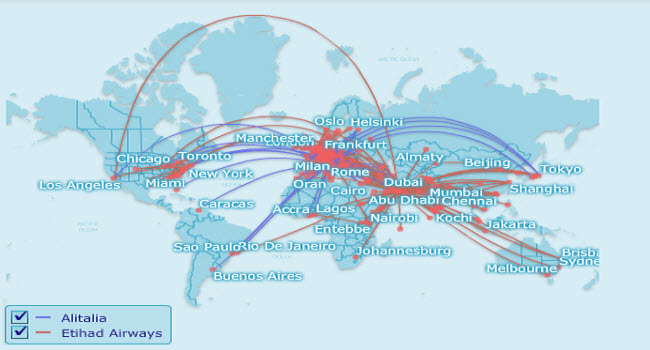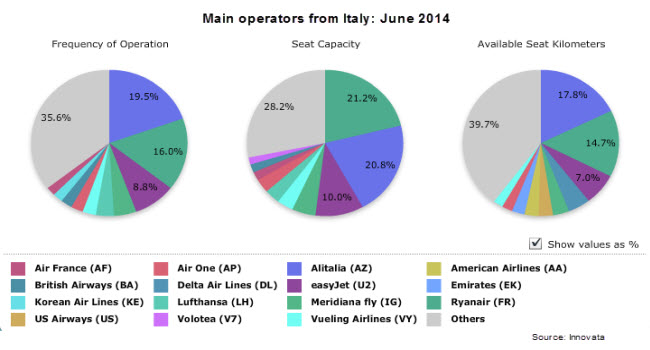Etihad Airways’ plan to acquire a 49% stake in Alitalia is a step closer to fruition after the two carriers agreed the principal terms and conditions under which the tie-up will take place.
While talks on the deal have been the subject of intense media interest, the carriers have divulged little information regarding their future plans, although Italy’s transport minister has suggested Abu Dhabi-based Etihad will pump some €1.25 billion ($1.7 billion) into the Italian flag carrier over the next four years.
That will ease Alitalia’s immediate cash-flow problems and give it the ability to continue operations. But what kind of synergies can the carriers hope to achieve together, and what are Etihad’s chances of turning the loss-making Italian airline around?
Fleet and route network
Opportunities for synergies across the two airline’s fleets and networks can quickly be identified.
Flightglobal’s Ascend Fleets database shows Alitalia has a large narrowbody fleet consisting of 91 Airbus A320-family aircraft, of which 81 are in service. The carrier has a long-haul fleet of 12 A330s and 10 Boeing 777s. Its subsidiary Air One has a further nine A320s, and regional arm Alitalia Cityliner has 20 Embraer 175/190 jets.
Etihad has a much smaller narrowbody fleet consisting of 28 A320-family aircraft, but has on order 26 A320neos plus two A320ceos and seven A321s. The carrier’s long-haul fleet is of course more sizeable: it operates 42 A330/A340s, 23 777s and three 747s, and has on order 71 787s, 62 A350s, 27 777s, 10 A380s and two A330s.
Few details have emerged regarding the future structure of Alitalia’s fleet under a tie-up, but having seen the initial business proposal, pilot union ANPAC foresees the two carriers removing 14 medium-range and adding seven long-haul aircraft over the next three years.
Alitalia completed its most recent fleet-renewal programme in 2012, and Ascend data shows the carrier has no aircraft on firm order but holds options for eight A320s and eight A330s. A lessor order for 12 A350-800s earmarked for Air One was cancelled in April.
In Alitalia’s “new industrial plan” outlined last year, chief executive Gabriele Del Torchio said six long-haul aircraft would be introduced to the fleet by 2016 as part of a new emphasis on long-haul routes. However, it is unclear whether this strategy will continue under the new deal.
“The fleets are reasonably compatible, for now. The additions of the A380 and 787 aircraft to Etihad’s fleet will change part of that dynamic,” says Wayne Plucker, director of North America aerospace and defense for consultancy Frost & Sullivan.
Innovata schedules show the Alitalia-Air One network has a strong focus on European and domestic markets. This could provide feed into Etihad’s Abu Dhabi hub operation. The carriers have an existing codeshare which could be expanded.
The Alitalia long-haul network will also give Etihad additional access to US East Coast destinations, West Africa and some new destinations in South America, such as Rio de Janeiro and Caracas.

Source: FlightMaps Analytics
“The biggest opportunity would be in route structure. Etihad would like more access to European locations and Alitalia to Middle Eastern locations. This allows them to use each other’s feeder system into their long-haul. It could also allow improved selection of long destinations through codesharing. This would allow each to become ‘expert’ in one region (other than their home region),” says Plucker.
Peter Morris, chief economist with Flightglobal consultancy Ascend, accepts that synergies are possible but offers a more cautious take, arguing that the tie-up will not solve some very fundamental problems.
“Low-cost carriers have now taken a significant share of traffic from Alitalia, and if the strategy is to reduce Alitalia’s costs, this will probably mean reducing its size and presence. This isn’t going to solve the fundamental competition issues,” says Morris.
Alitalia has seen its share of the Italian market steadily eroded over recent years as rivals such as Ryanair and EasyJet have taken a bite out of its regional and domestic traffic, while the likes of Lufthansa, Delta and Air France have torn into its long-haul business.
Flightglobal’s Innovata schedules for June indicate that Etihad and Alitalia will face a tough battle wresting back market share from Ryanair which has a 21.2% chunk of seat capacity into Italy, making it the largest carrier operating to the country. Ryanair and EasyJet have also established bases at Rome Fiumicino, blowing open Alitalia’s once-formidable fortress hub.
One possibility is that Alitalia and Air One could expand co-operation with Etihad’s partners such as Etihad Regional, Air Berlin and Aer Lingus but, more fundamentally, Morris says Alitalia’s business model is “clearly not working” in its present form and the only solution is a fresh approach that offers something different from competitors.

There is also the possibility Etihad could begin operating its own metal from Italy thanks to the country’s bilateral agreement with the UAE. This gives carriers based in the Gulf state fifth-freedom rights to operate international routes from Italian soil. But Ascend’s Morris is hesitant about the prospects for such a venture.
“In terms of effect, we could certainly see this might work, but I am aware of the recent problems experienced by Norwegian in operating its transatlantic services, with objections from the USA. There is a question mark now over how open the US-EU open skies really is – that would all need to be handled very carefully,” he says.
Indeed, Emirates has already run into trouble trying the same thing with a Dubai-Milan-New York service, which has been declared illegal by an Italian court. The airline has lodged an appeal which is outstanding. Should Etihad try the same thing, the path may be smoother, given it will be in co-operation with Italy”s home carrier.
Maintenance
The proposed tie-up between Etihad and Alitalia could provide synergies for the two airlines in their MRO operations.
“Since both operate A319, A320, A321 and A330 aircraft as well as the 777, they could potentially choose one location as the long-haul maintenance facility and the other as the short-haul, or one as the Boeing facility and the other as the Airbus facility,” says Plucker.
“It is likely that Alitalia’s long-haul fleet would be minimised and MRO for those aircraft would be outsourced. Some adjustments to the European route structure for Alitalia can be expected,” he adds.
One possibility is that Alitalia could shift its narrowbody maintenance work to Abu Dhabi Aircraft Technologies, which Etihad is in the process of acquiring. However, to do so the carriers would need to break Alitalia’s existing contract with Naples-based Atitech, which is contracted for work on its A320s until 2020.
Antonio Di Lieto, Atitech’s business development director, says there has been no indication of a change of plan by the Italian carrier: “We have had no requests to change the relationship, and we are waiting to hear more. Also, remember that Alitalia is a 15% shareholder in Atitech.”
Staffing and leadership
Historically, Etihad has not just brought fresh capital to its airline partners: it has also brought expertise. Following its taking of an equity stake in Air Seychelles in 2012, Etihad parachuted in problem-solver Cramer Ball as the airline’s chief executive.
Having turned that carrier around, Ball is now moving to Jet Airways, another Eithad equity partner, as chief executive. Other recent moves include Shelley Cole, previously on secondment from Etihad to Air Seychelles as finance chief, who is now performing the same role at Etihad Regional.

Frost’s Plucker says “executive changes are likely” at Alitalia too following the tie-up but “probably one at a time to eliminate leadership challenges”.
He adds: “Jobs losses, both in flight and ground crew personnel are probably overdue and can be expected.”
Italian transport minister Maurizio Lupi has suggested that job cuts in the region of 2,000 should be expected.
How easy this will be to introduce is unclear. Alitalia is unionised and the country has strong labour laws, but the airline’s restructuring and its dire financial difficulties over recent years have perhaps lessened the desire of workers to fight further changes – and ANPAC, for one, has welcomed the tie-up with Etihad.
Source: Cirium Dashboard



















